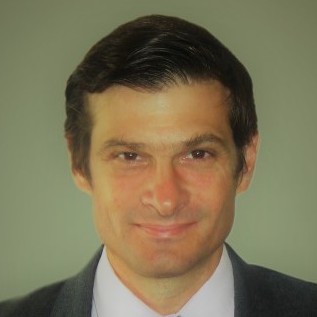
Chief of Kidney and Pancreas Transplants programs at CEMIC ( Centro de Ecudacion Medica e Investigaciones Clinicas)
Aggregate Porofessor at IUC ( Instituto Universitario CEMIC)
Graduated with honors at the University of Buenos Aires in 1992
Internship in Internal medicine at CEMIC
Fellowship in Nefrologhy at CEMIC
Gragraduated Nephrologist at University of Buenos Aires
AFSA in Nephrology. Universite Lyon I. Hospital Edouard Herriot. Lyon. France
Organ Transplantation Diploma . Universite Lyon I. Hospital Edouard Herriot. Lyon. France
Renal transplantation in the elderly. Are they all the same? A multicenter, comorbidity based study
Guillermo Fragale1, Gustavo Laham2, Pablo Raffaele3, Marcela Fortunato3, Susana Villamil4, María Cora Giordani4, Marcelo Taylor5, Julio Ciappa5, Marisol Rodriguez6, Rafael Maldonado6, Hernán Trimarchi7, Vanesa Pomeranz7, Virginia Ellena8, Jorge De La Fuente8, Liliana Bisigniano9, Ariel Antik9, Gervasio Soler Pujol1,2.
1Nefrología y Trasplante renal, Hospital Universitario Austral, Universidad Austral, Pilar, Argentina; 2Sección Nefrología, Centro de Educación Médica e Investigaciones Clínicas "Norberto Quirno, Buenos Aires, Argentina; 3Unidad Renal, Fundación Favaloro, Buenos Aires, Argentina; 4Trasplante renal, Hospital Italiano, Buenos Aires, Argentina; 5Centro Regional de Ablación e Implante Sur, Hospital San Martín, La Plata, Argentina; 6Nefrología y Trasplante renal, Clínica Vélez Sarsfield, Cordoba, Argentina; 7Servicio de Nefrología, Hospital Británico, Buenos Aires, Argentina; 8Servicio de Nefrología, Hospital Privado Universitario de Córdoba, Córdoba, Argentina; 9Dirección Científico Técnica, Instituto Nacional Central Único Coordinador de Ablación e Implante, Buenos Aires, Argentina
Background: The age for renal transplantation (RT) is no longer a limitation and several studies have shown benefits in the survival of elderly patients. The aim of this study was first, to examine the relationship of the baseline Charlson comorbidity index (CCI) score to morbidity and mortality after transplantation, and second to identify other variables affecting patient and graft survival.
Methods: In this multicentric observational retrospective cohort study, we included patients older than 60 years admitted on the waiting list (WL) for deceased donor RT from 01/01/2006 until 31/12/2016 in the eight participating centers. The CCI score was calculated for each patient at inclusion on the WL.
Results: Data for analysis was available of 387 patients. Mean age was 68±6,2 years, 60% were males. The patients were divided in tertiles of CCI: group 1(CCI:1-2) n=117, group 2 (CCI: 3-4) n=158 and group 3(CCI: ≥5) n=112. Median time on dialysis before RT was 51(29-73) months. Median follow up time after RT were 53 (16-85) months. Median CCI score for the whole cohort was 3 (2-5). The number of infectious disease re-admissions were higher along the CCI groups. The number of surgical complications were significantly higher in CCI group 3 (30.4 %), p< 0.013. Acute rejection (AR) was less frequent in patients with high CCI score compared to group 1 (p<0.013). Survival of patients with functioning graft was significantly different between CCI groups at 1, 3 and 5 years respectively: 90%, 88% and 84% for group 1, 88%, 80% and 72% for group 2, and 87%, 75% and 63% for group 3. Log Rank test: 15.660, P< 0.0001. Variables significantly associated with mortality were: CCI score [OR=1.73 (IC 1.392-2.169), p=0.0001], Delayed graft function (DGF) [OR=0.14 (IC 0.005-0.477), p=0.001], HLA mismatch [OR=1.39 (IC=1.059-1.849), p=0.018], length of hospital stay [OR=1.04 (IC 1.022-1.058) p=0.0001], surgical complications [OR=5.87 (IC 1.737-17.462), p=0.004], and creatinine at 5 years [OR=1.30 (IC 1.093-1.547) p=0.003]. Death censored graft survival was not different between the 3 CCI groups. Variables significantly associated with graft loss were: AR [OR=8.06 (IC 1.305-49.807), p=0.025], creatinine at 3 years [OR=7.06 (IC 2.863-17.443), p=0.0001] and proteinuria at 3 years [OR=1.00 (IC 1.001-1.003), p=0.004]
Conclusions: Individualized strategies to modify these variables may improve patient´s morbidity and mortality after RT.

right-click to download
